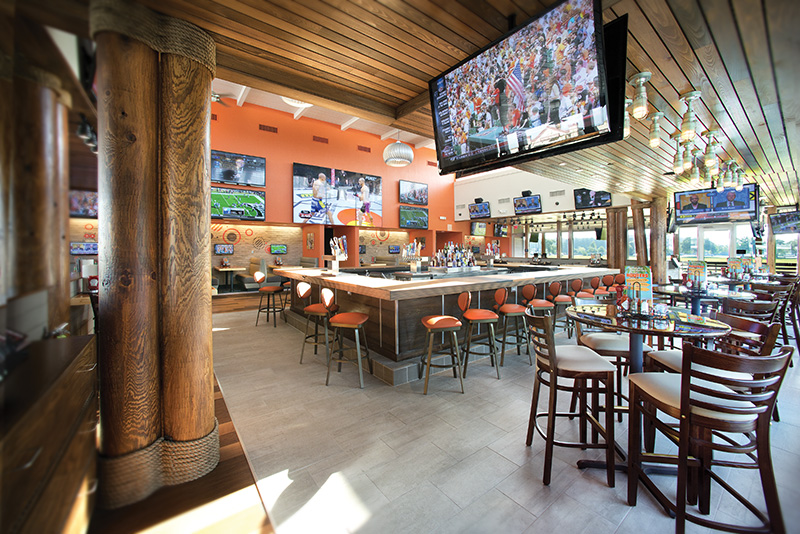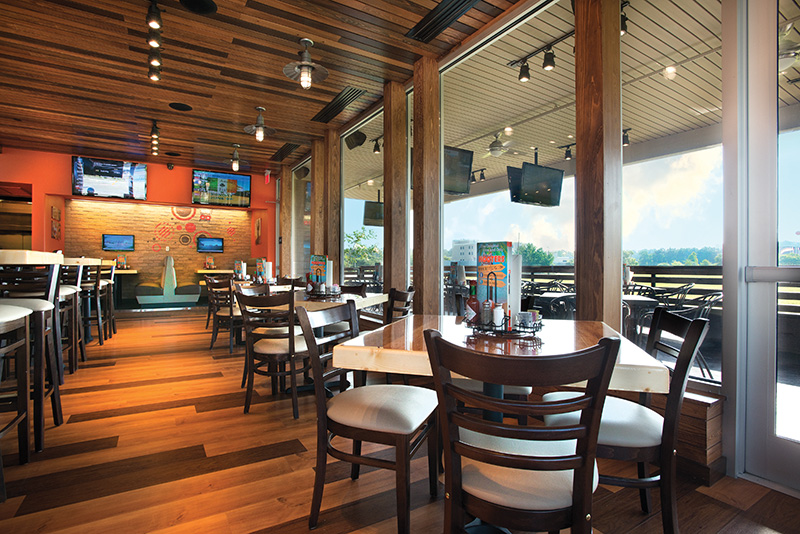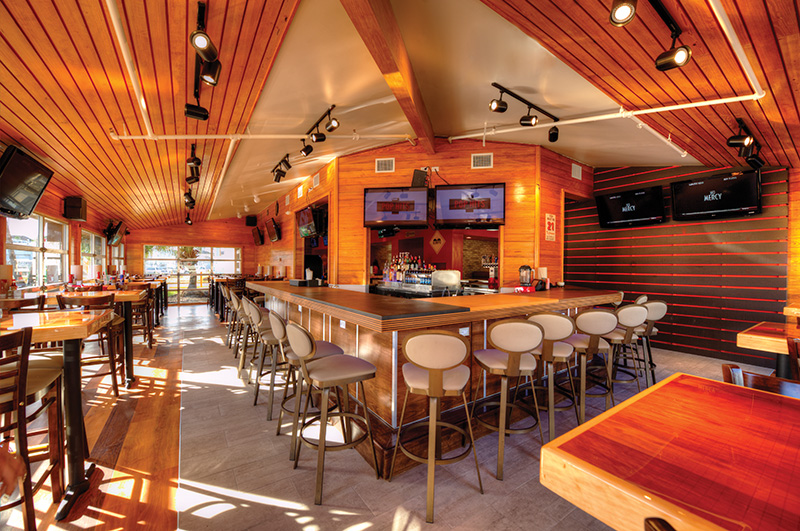In time for its 30th anniversary, Hooters of America opens the first ground-up location featuring its new restaurant design.
Interview by Katie Lee
Hooters sure knows how to grab your attention. With 20 remodels underway or completed in 2013 — and the same pace expected next year — Hooters of America has customers looking twice thanks to an impressive nationwide makeover in conjunction with its 30th anniversary. Restaurant Facility Business Editor Katie Lee recently interviewed Fred Sigmund, senior director of development, real estate and construction, about Hooters’ new prototype design, the future of the brand, and the company’s plans for repair and maintenance.
RFB: How many restaurants does Hooters of America operate today? How many new locations opened in 2013, and what is the growth forecast for 2014?
 Sigmund: Hooters of America, LLC is the franchisor and operator of more than 412 Hooters restaurants in 44 states and 27 foreign countries. We have approximately 20 total remodels in progress or completed this year, and Hooters will maintain or even accelerate the pace in 2014.
Sigmund: Hooters of America, LLC is the franchisor and operator of more than 412 Hooters restaurants in 44 states and 27 foreign countries. We have approximately 20 total remodels in progress or completed this year, and Hooters will maintain or even accelerate the pace in 2014.
RFB: Hooters celebrated its 30th anniversary this October. Tell me a little about the history of the company and what its goals are for the future.
Sigmund: Hooters was ironically incorporated on April Fool’s Day — April 1, 1983 in Clearwater, Florida. The first Hooters location opened October 4, 1983, in Clearwater, by the original “Hooters Six” founders. It was just a scant beach shack, but the Hooters brand has grown to become one of the most successful and recognizable dining destinations in the world.
 Hooters has had a monumental 30th anniversary year that will certainly set the tone for the future. Hooters unveiled a new contemporary restaurant design with the remodeled Hooters of Kirby, Texas, and the ground-up prototype Hooters of Slidell, Louisiana, just outside of New Orleans.
Hooters has had a monumental 30th anniversary year that will certainly set the tone for the future. Hooters unveiled a new contemporary restaurant design with the remodeled Hooters of Kirby, Texas, and the ground-up prototype Hooters of Slidell, Louisiana, just outside of New Orleans.
Not only did its locations receive updates, but the “Hootie” logo received a modern makeover, giving the iconic owl a sleek new look that embodies the brand’s contemporary transformation while keeping in line with its heritage.
RFB: Hooters of Kirby in Houston underwent a renovation at the beginning of 2013. What were some of the changes made to that store?
 Sigmund: With a brand new interior and exterior design featuring sleek and contemporary finishes and a more comfortable dining experience, the rebuild of the 20-year-old Hooters of Kirby, Texas, location will serve as a prototype for all future Hooters locations to come.
Sigmund: With a brand new interior and exterior design featuring sleek and contemporary finishes and a more comfortable dining experience, the rebuild of the 20-year-old Hooters of Kirby, Texas, location will serve as a prototype for all future Hooters locations to come.
Among some of the new design elements include a new high exposed ceiling, painted ductwork and cypress wood walls that give a more open and brighter appearance, and materials such as light colored face brick provide texture throughout the space.
The Hooters of Kirby location also offers a more centrally located and prominently placed bar, complemented with swiveled bar stools. The remodeled location also features new booth seating and high-back chairs at all tables.
RFB: Tell me about the Slidell, Louisiana, location. It is the first ground-up construction using the new prototype, correct? When was it completed?
Sigmund: The brand new Hooters of Slidell, Louisiana, location was completed and opened this past June and is the first ground-up prototype for Hooters. The Slidell design serves as a model for all future new build Hooters locations, and it will influence enhancements and renovations to existing locations.
RFB: How did Slidell improve upon the Kirby model?
 Sigmund: Bolstering the momentum of the Kirby remodel, the 6,300-square-foot Hooters of Slidell, located 30 miles from New Orleans, continues many of the design elements. It’s got a cleaner and brighter feel, with expansive windows, higher ceilings and more open space to encourage social interaction.
Sigmund: Bolstering the momentum of the Kirby remodel, the 6,300-square-foot Hooters of Slidell, located 30 miles from New Orleans, continues many of the design elements. It’s got a cleaner and brighter feel, with expansive windows, higher ceilings and more open space to encourage social interaction.
The building itself touches on the modern, with a rustic undertone in order to maintain aspects of Hooters beach oasis heritage. The design features clean lines and sleek finishes on the interior and exterior of the building, but there’s still a nod to the past with the use of wood throughout the space.
RFB: Have other locations been remodeled or is that an initiative for 2014?
Sigmund: Hooters and its franchisees are moving forward with remodel and building projects, including Hooters locations in Council Bluffs, Iowa; Pointe Orlando, Florida, and Chattanooga, Tennessee. Hooters has also invested in refreshing existing stores with incremental enhancements such as more large-screen TVs, new sound systems, larger windows and patios, and more comfortable furnishings. Depending on which elements are applied and how in-depth the construction process is, the investment will vary. This initiative will continue into 2014.
RFB: How will the new prototype aid the facilities and operations team? Were there some challenges in the past that have been resolved or improved upon?
Sigmund: With the new build locations and remodels, Hooters is implementing a more efficient kitchen design for faster service. We also incorporated new booth seating and high-back chairs at all tables with clear lines of sight to more TVs.
RFB: What is the new typical square footage of a Hooters restaurant?
Sigmund: Approximately 6,300 square feet.
RFB: Describe how Hooters handles repair and maintenance.
Sigmund: We have facility managers that handle between 60 and 70 stores each, and they will contract with outside vendors. Hooters is currently looking for the right opportunity to partner with a facility maintenance software management system.
RFB: Do you use local or national vendors? Why?
Sigmund: Because we operate across multiple states, we use some national vendors for certain things — like hood cleaning, for example — but we usually localize for things like preventive maintenance and immediate repair needs.
RFB: By what criteria do you choose your R&M vendors?
Sigmund: We always look for the best business partner and quality of work because we like to form relationships with our vendors.
RFB: How does Hooters handle a typical maintenance call? An emergency call?
Sigmund: It depends on what level of need and what the emergency is. The Hooters management staff is empowered to make the decisions they need in order to run their business. The restaurant management works very closely with our facility managers, but the situation will depend on how it is handled. For example, major repairs, upgrades and construction are handled by the facility manager; repairs at the field level might be handled in tandem with management and facility managers; while an immediate need or straightforward fix may be managed locally by the manager.
RFB: Does your maintenance, operations or construction group have any “green” initiatives in place or in the works?
Sigmund: We have currently tested and done an ROI analysis on upgrading to LED lighting, which we will be preparing a program for in the near future. Any equipment or building systems that need replacing, we look to replace with the most energy-efficient solutions on the market.
RFB: What do you enjoy most about your job day to day?
Sigmund: Besides working for a fun brand like Hooters, I enjoy the constant change of pace that construction and facilities bring. There’s always something that will challenge me to think differently and find new solutions, which also creates a great learning environment.
RFB: What goals have you set for your team, short term and long? Five years from now?
Sigmund: As we celebrate our 30th anniversary, we are even more excited and focused on the future. Long term, we want to continue to be a part of the communities we serve and continue to focus on attracting new customers with great food, our upbeat atmosphere and legendary, uniquely Hooters service. Hooters of America will continue to foster relationships with its franchisees to continue expansion into new markets worldwide.
[NOTE: This article originally appeared as the cover story of the October/November 2013 issue of Restaurant Facility Business magazine. Email the editor at [email protected].]
